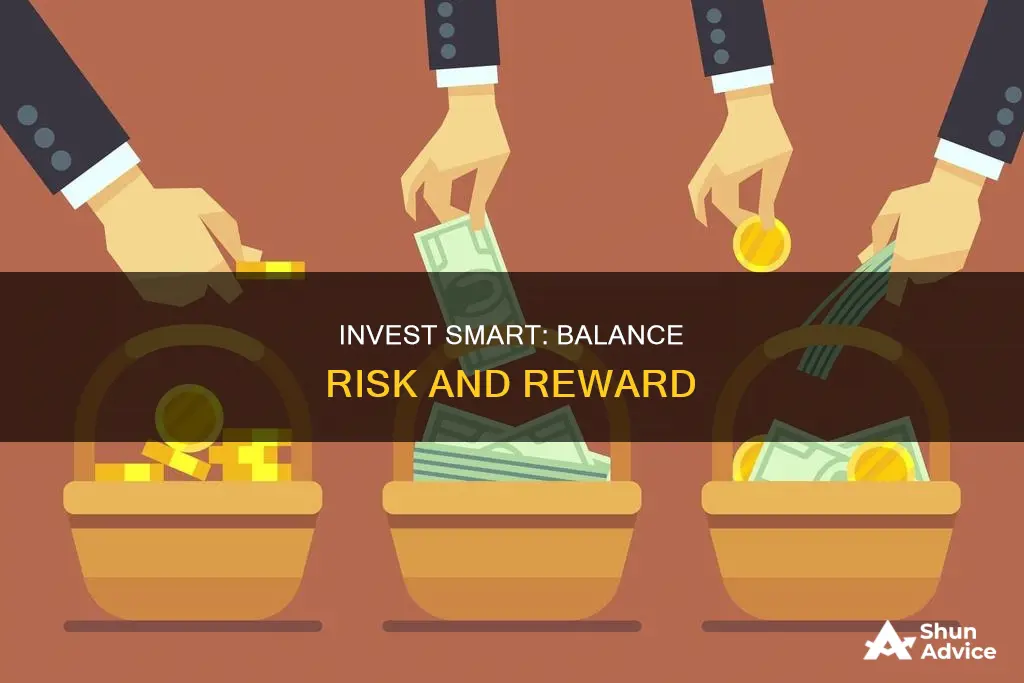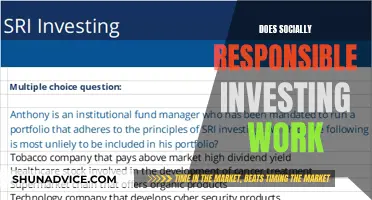
Finding the right balance when investing is a complex process that requires careful consideration of various factors. It involves striking a balance between saving and investing, as well as managing risk and return. While saving is essential for financial security, investing is crucial for wealth creation and achieving long-term financial goals. Therefore, understanding the differences between saving and investing is vital. Saving refers to putting money aside for future use, typically in low-risk accounts with easy access, like savings accounts. On the other hand, investing involves putting money into financial products like stocks, bonds, or real estate to grow wealth over time, but it comes with higher risks.
When it comes to investing, individuals must determine their risk tolerance and financial objectives. Diversification of investments is often recommended to reduce risk and maximise returns. Additionally, consulting financial experts and staying informed about market predictions and historical returns can aid in making prudent investment decisions. Ultimately, finding the right balance in investing entails tailoring strategies to one's personal circumstances, risk appetite, and financial goals.
| Characteristics | Values |
|---|---|
| Risk | Choose the level of risk you are comfortable with |
| Returns | Check historic returns to determine the safety of your money and the likelihood of high returns |
| Market Predictions | Pay attention to current and future economic and political environments that could impact future prices and values |
| Diversification | Diversify your investments to reduce the risk of losing it all |
| Financial Education | Seek financial education and literacy to find the right balance between saving and investing |
| Purpose | Determine the purpose of your investment, e.g. saving for retirement, buying a home, etc. |
| Risk Appetite | Assess your risk appetite, i.e. conservative preservation of capital or a higher tolerance for risk |
| Liquidity | Consider the liquidity of your investment, i.e. how accessible your funds are |
| Returns | Evaluate the potential returns of your investment |
What You'll Learn

Choose your risk level
When it comes to investing, it's important to determine your risk tolerance and shape your strategy accordingly. Risk tolerance is the level of risk an investor is willing to take. It's about balancing the potential for opportunity and excitement against the possibility of losses and market volatility.
To understand your risk tolerance, ask yourself some questions: How do you feel when you hear the word "risk" in relation to your finances? Do you see an opportunity for great returns, or do you worry about losing everything? What would you do after a significant investment loss? What have you done in the past when markets took a turn for the worse? Providing honest answers to these types of questions can help you build a portfolio that aligns with your risk comfort level.
Your risk capacity, or how much investment risk you can take on, is determined by your financial situation, goals, and timeline. It's flexible and can change over time. For example, if you have financial dependents or a mortgage, you may be less likely to take on high-risk investments. Similarly, a financial shock, like job loss or unexpected medical bills, can impact your risk capacity.
Your time horizon, or the amount of time you plan to keep your money invested, is another crucial factor in determining your risk tolerance. Generally, a longer time horizon allows for a higher risk appetite, as there is more time to recover from potential losses. Conversely, a shorter time horizon may require a more conservative approach to avoid forced sales at a loss.
To find the right balance, consider using the investment risk pyramid as a framework. This asset allocation strategy places low-risk assets like cash and treasuries at the bottom and riskier assets like growth stocks at the top. The middle tier includes moderately risky assets like corporate bonds and blue-chip stocks. The pyramid structure helps balance risk and reward based on an individual's time horizon, assets, and risk tolerance.
Remember, risk and reward are inherently linked in investing. Higher-risk investments offer the potential for larger returns, while lower-risk investments may provide more modest profits but with a lower chance of significant losses. Choose the risk level you are comfortable with and seek expert advice when needed.
Equity for Investment: What's a Fair Trade?
You may want to see also

Check historic returns
Historical returns refer to the past rate of return and performance of a financial asset, such as a bond, stock, security, index, or fund. They are often associated with the past performance of a security or index, like the S&P 500.
Analysts and investors study historical return data to forecast future returns and make informed investment decisions. Historical returns can provide insights into how a security or market has reacted to various variables, including economic cycles and global events. It's important to note that past results do not guarantee future returns, and older historical data may be less effective in predicting future outcomes.
To calculate the historical return, subtract the most recent price from the oldest price and divide the result by the oldest price. For example, to calculate the return of the S&P 500 for 2019:
4,766 - 3,756) / 3,756 x 100 = 27%
Historical returns can be calculated for various financial assets, including stocks, bonds, mutual funds, exchange-traded funds (ETFs), real estate, and commodities.
When checking historical returns, it's important to consider the following:
- Historical data provides context: Analyzing historical returns can provide context for the current market conditions and how an asset's price may react in the near future. While it doesn't predict future returns, it helps investors make more informed decisions.
- Long-term perspective: Historical returns over a longer period, such as 5 or 10 years, can help identify trends and patterns. It's important to compare returns across different time frames to understand the variability of returns.
- Impact of reinvested dividends: Reinvested dividends can significantly impact overall returns. For example, reinvested dividends have accounted for 32% of the S&P 500's return since 1926.
- Inflation adjustment: When evaluating historical returns, consider the impact of inflation. Inflation erodes the purchasing power of your investments over time.
- Comparison with relevant indices: Compare the historical returns of a specific investment with relevant market indices, such as the S&P 500 or NASDAQ, to understand how it has performed relative to the broader market.
- Understanding average returns: Average historical returns may not capture the full picture due to fluctuations in returns over time. Some years may have seen significant increases, while others experienced declines.
- Online resources: Utilize online resources, such as Investopedia, online brokerage sites, and financial websites, to access historical price quotes and data for various investments.
Regression Analysis: Predicting Investment Returns
You may want to see also

Pay attention to market predictions
When investing, it is important to pay attention to market predictions. This means staying informed about the current and future economic and political environments, which can impact the future prices and values of your investments. For example, inflation and interest rates, tax laws, and geopolitical factors can all affect the stock market.
Market predictions can be made through a variety of methods, including prediction markets, where people trade contracts based on future events, and by reviewing past pricing history. However, it is worth noting that the accuracy of these predictions can vary, and external factors can always influence outcomes.
When investing in foreign currencies or markets, it is crucial to be aware of any economic or political uncertainty that may impact your investments. For instance, an economic downturn or political instability could lead to a decrease in your net worth. Diversifying your investments can be a way to mitigate this risk.
Additionally, it is important to remember that market losses are normal, and recovery is possible for investors who stay the course. As an investor, you can choose how much risk you are willing to take. If you are unsure, it is always best to consult a financial expert for advice.
By staying informed about market predictions and understanding the risks involved, you can make more informed decisions about your investments and be better prepared for any potential ups and downs in the market.
Uninvested: The Emotional Impact
You may want to see also

Diversify your investments
Diversifying your investments is a crucial aspect of managing your financial portfolio. Here are some detailed tips to help you diversify effectively:
Spread the Wealth
It is essential to diversify across different industries, sectors, and asset classes. Avoid putting all your investments in one sector, even if it is currently performing well. For example, instead of solely focusing on the pharmaceuticals sector, consider branching out into sectors like education technology or information technology. Diversification across sectors helps protect your portfolio from downturns in any one industry.
Balance Stocks and Bonds
Stocks are typically associated with higher risk and higher returns, while bonds are more stable and offer lower returns. To diversify your portfolio, strike a balance between these two options. A common rule of thumb is to subtract your age from 100 and invest that percentage in stocks, putting the remainder in bonds. For instance, a 30-year-old might opt for a portfolio of 70% stocks and 30% bonds.
Explore Different Investment Vehicles
In addition to stocks and bonds, there are numerous other investment options to consider. These include commodities, exchange-traded funds (ETFs), real estate investment trusts (REITs), and money market securities such as certificates of deposit (CDs) and treasury bills (T-bills). By diversifying into these alternative investments, you can further spread your risk and potentially access bigger rewards.
Consider Index and Bond Funds
Adding index funds or fixed-income funds to your portfolio is a great way to diversify. These funds track various indexes and aim to match the performance of broad markets, providing a wonderful long-term diversification strategy. Index funds also tend to have low fees, putting more money back in your pocket. However, keep in mind that their passively managed nature might be suboptimal during inefficient market periods.
Keep Building and Rebalancing Your Portfolio
Regularly add to your investments and consider using a strategy like dollar-cost averaging to smooth out market volatility. This approach involves investing the same amount of money over time, helping you buy more shares when prices are low and fewer when prices are high. Additionally, remember to periodically rebalance your portfolio to maintain the appropriate weight for each investment. This ensures you stay on track with your diversification strategy.
Go Global
Don't limit yourself to domestic investment opportunities. Explore international markets, especially emerging markets or regions with strong long-term growth potential, such as China. By investing globally, you not only access a wider range of opportunities but also protect yourself from negative events specific to any one country or market.
Remember, diversification is a powerful tool for managing risk and smoothing out the inevitable peaks and valleys of investing. However, be cautious not to over-diversify, as holding too many overlapping or correlated investments may dilute the benefits of diversification.
What Your Neighbors Are Investing In
You may want to see also

Understand the difference between saving and investing
Understanding the difference between saving and investing is crucial for your financial security and future. While both involve putting money away for future use, they have distinct characteristics and serve different purposes. Here's a detailed overview:
Saving
Saving refers to storing money safely to meet short-term financial goals and prepare for unexpected expenses. It involves setting aside a portion of your income in a savings account, money market account, or a certificate of deposit (CD) that earns interest over time. Saving is essential for building an emergency fund and provides liquidity for purchases. It is generally considered low-risk since your money is protected, but it also offers low-interest rates. Saving is ideal if you need access to your funds in the near future and want to avoid potential losses associated with investing.
Investing
Investing, on the other hand, involves putting your money into financial instruments such as stocks, bonds, mutual funds, real estate, or cryptocurrencies. It carries a higher level of risk but also offers the potential for higher returns over the long term. Investing is suitable for long-term financial goals, such as saving for retirement, a child's education, or a down payment on a house. It is important to note that investing requires a longer time horizon, and you should be comfortable with the potential risk of losing money.
Key Differences
The main distinction between saving and investing lies in the level of risk and the potential for returns. Saving typically offers lower returns but with minimal risk, while investing provides an opportunity for higher returns but carries the risk of losing some or all of your investment. Saving is ideal for short-term goals and provides easy access to funds, whereas investing is geared towards long-term wealth creation and achieving financial goals.
Finding the Right Balance
Finding the right balance between saving and investing depends on your financial situation, goals, and risk tolerance. It is recommended to have an emergency fund covering at least three to six months' worth of living expenses before investing. Additionally, if you have high-interest debt, such as credit card balances, it is advisable to pay it down before investing. Investing is suitable for money you won't need for at least five years and can be an excellent way to take advantage of employer matches in retirement accounts, such as a 401(k).
In conclusion, both saving and investing are essential components of a comprehensive financial plan. Saving provides a safety net and liquidity, while investing offers the potential for higher returns to achieve long-term goals. By understanding the differences and carefully considering your circumstances, you can make informed decisions about when to save and when to invest, ultimately working towards a secure financial future.
Tesla: Invest or Avoid?
You may want to see also
Frequently asked questions
Saving is keeping money in a safe place for future use, such as an emergency fund. Investing is putting your money into financial products to grow your wealth over time.
Savings accounts, government bonds, and fixed-deposit accounts are all safe options for storing your money.
Stocks, bonds, mutual funds, real estate, and gold are all common investment options.
It's important to choose a risk level that you are comfortable with. If you are unsure, consult a financial expert.
It's important to have both savings and investments. A good rule of thumb is to save enough to cover at least 3 months' worth of basic living expenses, and invest the rest towards your financial goals.







